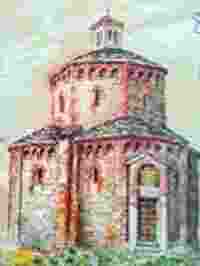Biography

Benedict was born in the small town of Norcia around 480 A.D. and it is considered the patriarch of Western monasticism, because it was the main legislator, reformer and unifier. He was sent by his parents to Rome, however, fearing perverted contact of bad examples of his students, he retired into solitude first at Enfide, country of Sabina, and then in nearby Subiaco where a monaco, Romano, the religious robe dressed .
Join Us
Saint Benedict patron of Europe
Benedict was born in the small city of Nursia towards the 480 D.C. and he is considered the Father of Western monasticism of which he was the main legislator, reformer and unifier. He was sent to Rome by his parents, but repelled by the vices of his companions he fled to Enfide, a Sabina village, then to Subiaco, where he received the habit from a monk named Romanus.
He was asked to be their abbot by a community of monks at Vicovaro. He accepted, but when the monks resisted his strict rule, he returned in solitude to the life of a hermit. He built twelve little monasteries, which was destroyed in the passing time except for the present Monastery of Saint Scholastica.
In Subiaco he began to spread his Rule in gross Latin in compliance with the spiritual and material requirements of the people (most of them were not ordained) who wanted to comply with it.
Benedict settled down on the mount dominating Liri’s valley. He destroyed the altars of the false divinities, cut the sacred small wood and preached assiduously for converting the pagan peasants left. The reputation of holiness of S. Benedict and of the virtues of his followers make very soon the coenobium famous so that it received considerable donations from the patrician Tertullo and from Gesulfo. Poor people went continuously to the mount and asked the thaumaturge for aid and protection. Ecclesiastics went and consulted the saint. The present mighty ones went and asked the prophet for sage teaching.
The Rule was applied to the inner and external life of the monk community until the sec. XII without contrast. It proposes to the religious a program of life based on prayer and work, on the stability of the place, the conversion of the customs and on the obedience under the patriarchal government of the Abbot.
Approximately forty days after he had seen his sister’s soul flying to Heaven like dove, Saint Benedict told some disciples the day of his death. Six days before he left this world he gave orders to have his sepulchre opened, then befallen by a violent fever, on 21st March he commanded his monks to carry him into the oratory.
After communicating, having his weak body held up between the hands of his disciples, he stood and prayed. As he was in that manner praying, he gave up the ghost. He was buried in the same grave with his sister under the altar of S. John the Baptist.
With this sign of salvation, Saint Benedict avoided the poison that some bad monks offered him. Benedict laid on the hand and crossed the glass with the death drink. The holy sign brake into shivers that vase of death like a stone had been thrown in place of a blessing. According to the story of Saint Gregory Magnum this episode should have inspired the words of the exorcism concerning the drink offered by the devil as well as the protection awarded to the sign of the cross.
Saint Benedict was a true monk. Its work was the fruit of an ascetic native wisdom from the fathers of the oriental deserts, and transmitted to the West across a patrimony as a rule, stories of pilgrimages, biography and dissertations. It denied the privileges of its patrician origin to himself shelter in the Subiaco forest to live from hermit. There, in the silence and in the ecstasy it matured the prophetic wisdom of the Holy Scriptures, it despised the world and increase to excess the burning desire to look for and bitter God.
 Benedict was born in the small town of Norcia around 480 A.D. and it is considered the patriarch of Western monasticism, because it was the main legislator, reformer and unifier. He was sent by his parents to Rome, however, fearing perverted contact of bad examples of his students, he retired into solitude first at Enfide, country of Sabina, and then in nearby Subiaco where a monaco, Romano, the religious robe dressed .
Benedict was born in the small town of Norcia around 480 A.D. and it is considered the patriarch of Western monasticism, because it was the main legislator, reformer and unifier. He was sent by his parents to Rome, however, fearing perverted contact of bad examples of his students, he retired into solitude first at Enfide, country of Sabina, and then in nearby Subiaco where a monaco, Romano, the religious robe dressed .